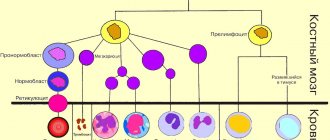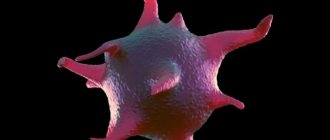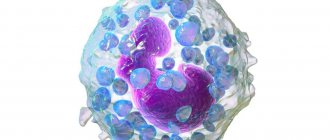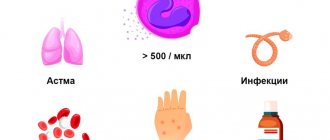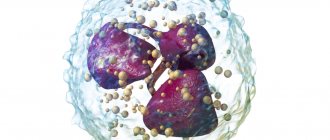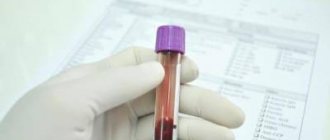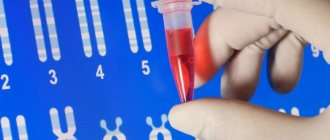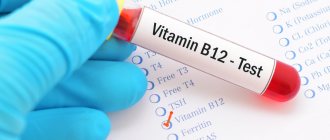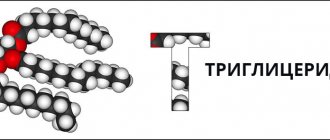Scientific editor: M. Merkusheva, PSPbSMU named after. acad. Pavlova, medical practice. September, 2021.
Normally, the relative amount of basophils in the blood should not exceed 1%. Basopenia and basophilia may indicate the presence of inflammatory processes, blood diseases, etc.
Determination of basophils as part of the leukocyte formula of a clinical blood test is carried out to identify inflammatory processes and allergic reactions.
Basophils themselves are a type of leukocyte and are blood cells derived from the granulocyte lineage.
What it is
Basophils are a type of leukocyte (white blood cell).
Produced in the bone marrow and present in small quantities in the body. The proportion of basophils from the total number of leukocytes in an adult healthy person is only 0.5-1%. This relatively small presence in the blood is enough for basophils to perform their functions. These include:
- Maintenance of allergic reactions. They migrate to allergic foci, where they release the contents of their granules (histamine, heparin), which ensures the maintenance of the allergic reaction1.
- Protection from foreign agents. Basophils are part of the innate immune system. They are activated upon contact with foreign agents. In particular, this is indicated for parasites.
- Sources of cytokines. Basophils secrete interleukins 3 and 4. In turn, the latter enhance the activity of other immune cells during infectious and inflammatory reactions.
- Improved blood flow. Basophils contain heparin, a blood thinner. During inflammatory processes, this allows immune cells to freely enter the site of inflammation.
Figure 1. Spatial model of the basophil. Image: Blausen.com staff (2014). "Medical gallery of Blausen Medical 2014". WikiJournal of Medicine 1 (2). DOI:10.15347/wjm/2014.010. ISSN 2002-4436 (CC BY 3.0)
Correction
A short-term increase in basophils during recovery from an acute viral infection or during pregnancy is an absolutely normal and harmless phenomenon that does not require any intervention. Persistent, and especially high (up to 5%) basophilic leukocytosis, requires correction by treating the disease that caused its development.
- Antiallergic treatment
. To eliminate allergy symptoms, it is first recommended to limit contact with the allergen as much as possible; antihistamines (loratadine, cetirizine) and glucocorticosteroids (prednisolone) are also used. A method that allows you to completely get rid of allergies is allergen-specific immunotherapy (ASIT). - Deworming
. For helminthic infestations, anthelmintic drugs (mebendazole, albendazole) are used. Very often, antiallergic drugs are additionally prescribed. - Anti-inflammatory treatment
. For autoimmune diseases, medications that suppress the inflammatory process are used - glucocorticoids, immunosuppressants (methotrexate, cyclophosphamide), 5-aminosalicylic acid derivatives (sulfasalazine), aminoquinoline derivatives (hydroxychloroquine). - Treatment of oncohematological diseases
. For malignant blood diseases, courses of chemotherapy consisting of a combination of cytostatic drugs (imatinib, vinblastine, vincristine) are prescribed. In polycythemia vera, hydroxyurea and alpha-interferon are effective in suppressing pathological hematopoiesis.
Blood test for basophils
Basophils are determined as part of a clinical blood test. In medical documents, the indicator is referred to as “basophils”, “BA%”, “BA” or “BASO”.
Typically, basophils are expressed as a percentage of the total number of remaining white blood cells (BA%). Their absolute number can also be indicated (BA - the number of cells per liter of blood). This is 0.01-0.065x109/l., which is approximately 0.5-1% of the total number of white blood cells.
Cell counting is performed in a special device - a hematology analyzer. This is also done manually. A blood smear is taken, stained with special dyes, after which the basophils are counted under a microscope.
Basophil activation testing is carried out as part of an allergy test. It is possible to find out which allergens the basophils are activated to in order to identify the specific allergen that causes adverse symptoms.
Leukocyte formula:
| Index | × 10x9/l | ratio, % | |
| Neutrophils | segmented | 2,1–5,4 | 43–71 |
| stab | 0,4–0,3 | 1–5 | |
| Basophils | up to 0.063 | up to 1 | |
| Eosinophils | 0,02–0,3 | 0,5–5 | |
| Lymphocytes | 1,1–3,1 | 17–38 | |
| Monocytes | 0,08–0,5 | 3–12 | |
Preparing for analysis
A general blood test requires proper preparation. Before the study, it is important to adhere to the following rules:
- Blood must be donated on an empty stomach. Otherwise, nutrients (entered into the blood) may interfere with the correct determination of the blood formula.
- You should refrain from smoking for several hours before donating blood.
- It is advisable to abstain from alcohol 2-3 days before the planned analysis.
- The day before donating blood, avoid physical and emotional stress.
- The day before you should refrain from taking medications (if possible). If you cannot refuse the medication, you should notify your doctor.
Basophils and estrogens
It has been established that drugs containing estrogen increase the number of basophils. Therefore, if you are taking such drugs, tell your doctor. When deciphering the analysis for basophil content, the specialist will make an adjustment for this.
The main factors for reducing hemoglobin
Hemoglobin levels decrease during pregnancy due to an increase in the total volume of circulating blood.
Pathological changes may indicate anemia:
- with large blood loss;
- chronic bleeding in small volumes (hemorrhoidal, uterine, etc.);
- with nutritional deficiency (iron-B12-folic deficiency);
- when transfusing large amounts of fluids and/or blood plasma;
- with massive destruction (hemolysis) of red blood cells;
- for various chronic diseases;
- with inhibition of the hematopoietic function of the bone marrow.
Any deviations from the norm require consultation with a therapist. If there are significant changes in hemoglobin levels, the patient is referred to a hematologist.
Be sure to regularly take a general blood test and undergo preventive examinations. The earlier the disease is detected, the more gentle and timely the treatment will be.
Norms of basophils in the blood
The normal level of basophils in the blood (BASO) changes in children under 2 years of age.
In adults (men and women), the norm is 0.5-1% (Table 1). Table 1. Norm of basophils (BASO) in the blood by age and gender
| Newborns | Up to 1 month | One year old children | Children under 2 years old | Adults (men, women) | |
| Basophil level (BASO) | 0,75% | 0,5% | 0,6% | 0,7% | 0,5-1% |
Causes of elevated basophils
A high level of basophils is called basophilia. This condition can be dictated by both pathological and physiological reasons. Let's take a closer look at them.
Physiological causes of increased basophils:
- Menstruation and ovulation, when there is a high level of female sex hormones in the blood. As mentioned above, estrogens increase the level of basophils.
- The recovery period after an infection (basophil levels may be elevated for several days or weeks).
- When exposed to small doses of radiation. Often, an increased number of basophils is observed among radiologists or laboratory technicians.
- After taking contraceptives containing estrogen.
Pathological causes of high basophil content:
- allergic reactions²;
- bone marrow diseases³;
- thyroid deficiency (hypothyroidism);
- inflammatory diseases;
- ulcerative colitis;
- autoimmune diseases (eg rheumatoid arthritis4);
- asthma;
- infectious pathologies (viral, bacterial, fungal, parasitic).
Basophilia in children can be caused by other reasons, including:
- poisoning;
- parasites (worms);
- insect bites;
- anemia (iron deficiency, hemolytic);
- allergy;
- nephrotic syndrome;
- sinusitis;
- blood diseases;
- endocrine diseases (usually thyroid diseases);
- gastrointestinal pathologies.
Basophils are counted both manually and under a microscope. Photo: gstockstudio / freepik.com
Causes of low basophils
A decreased level of basophils is called basopenia. This condition is not dangerous to health. It can occur, for example, when basophils migrate from the blood to inflammatory foci. If the basophil has released its granules, then it is already considered inactive. Such cells are not taken into account when counting. For doctors, “empty” basophils serve as an additional diagnostic criterion, which indicates the presence of an inflammatory reaction.
Common causes of a pathological decrease in basophils include:
- Hyperthyroidism is an overactive thyroid gland.
- Urticaria is an allergic disease that manifests itself as a skin rash.
- Lupus is an autoimmune pathology in which foci of inflammation form in the joints, skin, heart and brain.
- Taking corticosteroid drugs. If you are taking such medications, please notify your doctor so that the results can be corrected.
- Depression. The mechanism of the decrease in basophils in depression is unknown, but the fact itself has been established.
- Smoking – contributes to a slight decrease in the level of basophils5. After giving up the bad habit, basophils rise again to normal levels.
Smoking reduces basophil levels. Photo: freepik.com
Diagnostics
To find out the cause of basophilic leukocytosis, you need to consult a medical specialist. The doctor asks the patient whether he has recently suffered an infectious disease or whether he suffers from allergic pathology. If there are any symptoms (joint pain, weight loss, spontaneous bleeding), they must be mentioned. Additional examination is also prescribed, including:
- Blood tests
. The total number of leukocytes and the leukocyte formula are calculated. The concentration of inflammatory markers - ESR, CRP - is determined. The ELISA method detects specific antibodies (IgM, IgG) to helminth antigens. An analysis is carried out for the presence of autoantibodies - antistreptolysin, Ab to double-stranded DNA. For the diagnosis of chronic myeloid leukemia, detection of the Philadelphia chromosome using cytogenetic research is informative. Tumor CD markers are found through immunophenotyping of blood cells. - Allergy diagnostics
. The allergic nature of the disease is confirmed by the high content of immunoglobulin E (IgE) in the blood. To identify the causative (“culprit”) allergen, special skin and provocative tests are carried out - application to the skin, intradermal administration, inhalation of various allergens. Mast cell degranulation tests (direct or indirect) are also performed. - Instrumental Research
. For the diagnosis of bronchial asthma, spirometry with a drug test plays an important role. In rheumatism, echocardiography shows damage to the valves, and sometimes effusion into the pericardial cavity. In case of oncohematological diseases, ultrasound of the abdominal organs reveals hepatosplenomegaly. With ulcerative colitis, fibrocolonoscopy reveals hyperemia and ulcerative defects of the mucous membrane. - Histological studies
. If a malignant blood disease is suspected, a sternal puncture or trephine biopsy is required to obtain a bone marrow sample. When examining it microscopically, diffuse hyperplasia of the granulocytic lineage and a large number of blast cells are noted.
How to reduce or increase basophils
The physiological causes of basophilia are short-lived and disappear after discontinuation of the factor that increases basophils. Thus, the abolition of hormonal contraceptives and avoidance of radiation bring basophils back to normal in a short time.
As for pathological basophilia, BASO levels can be normalized by starting treatment for the underlying disease. This includes antiallergic therapy, deworming (elimination of worms), treatment of inflammatory diseases and blood diseases.
To reduce the level of basophils in basophilia, it is also recommended to saturate the body with a sufficient amount of vitamin B12 (cyanocobalamin) and iron. These components are found in meat, offal, eggs, fish and dairy products. In some cases, the doctor prescribes preparative vitamin and mineral complexes with iron and B12.
Functions of basophilic granulocytes
- They support the blood supply to small blood vessels, thanks to which tissue cells are saturated with oxygen.
- Participate in the formation of new capillaries.
- Transmits a signal to other leukocytes for their further movement to the sites of localization of pathogenic agents
- Prevents the development of parasitic infections.
- Prevent the spread of poison throughout the body (for example, with a snake bite).
- Protect the skin and mucous membranes from the penetration of parasites.
- They form the body's response to the allergen. This is considered the main function of basophils.
- They take part in cleansing tissues of biologically active agents.
Symptoms
This pathological process does not have a specific clinical picture.
- Basophils in the blood are increased, decreased, the norm in women, adults, children by age
The collective symptomatic complex may include the following signs:
- poor appetite;
- drowsiness, apathetic mood;
- low-grade or elevated body temperature;
- disturbances in the functioning of the gastrointestinal tract;
- sleep cycle disturbance – the child does not sleep well at night, cannot fall asleep for a long time, often wakes up;
- rashes on the body;
- increased lacrimation, rhinitis;
- ARVI symptoms;
- general malaise, weakness.
Such symptoms have a variety of causes - from a simple cold to a complex infectious disease or poisoning. Therefore, parents should consult a doctor as soon as possible rather than carry out treatment on their own.
Pregnancy
During the first trimester of pregnancy, an additional circulation occurs. The volume of the liquid fraction of blood increases, but the number of formed elements does not change. The concentration of basophilic granulocytes decreases accordingly. For this reason, basophils are low or absent in the blood sample. Such an analysis is considered false, and a decrease in the absolute or relative number of basophilic granulocytes during pregnancy is considered normal.
